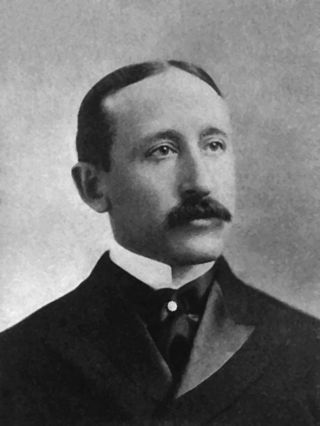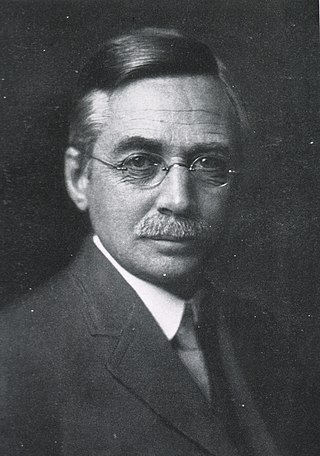Related Research Articles

The Geological Society of America (GSA) is a nonprofit organization dedicated to the advancement of the geosciences.

James Stephen Ewing was an American pathologist. He was the first professor of pathology at Cornell University and discovered a form of bone cancer that was later named after him, Ewing sarcoma.

Ernest William Goodpasture was an American pathologist and physician. Goodpasture advanced the scientific understanding of the pathogenesis of infectious diseases, parasitism, and a variety of rickettsial and viral infections. Together with colleagues at Vanderbilt University, he invented methods for growing viruses and rickettsiae in chicken embryos and fertilized chicken eggs. This enabled the development of vaccines against influenza, chicken pox, smallpox, yellow fever, typhus, Rocky mountain spotted fever, and other diseases. He also described Goodpasture syndrome.
The American Association for Cancer Research (AACR) is the world's oldest and largest professional association related to cancer research. Based in Philadelphia, the AACR focuses on all aspects of cancer research, including basic, clinical, and translational research into the etiology, prevention, diagnosis, and treatment of cancer. Founded in 1907 by 11 physicians and scientists, the organization now has more than 58,000 members in 142 countries and territories. The mission of the AACR is to prevent and cure cancer through research, education, communication, collaboration, science policy and advocacy, and funding for cancer research.

In histopathology, a Mallory body, Mallory–Denk body (MDB), or Mallory's hyaline is an inclusion found in the cytoplasm of liver cells. Mallory bodies are damaged intermediate filaments within the liver cells.

Eugene Lindsay Opie was an American physician and pathologist who conducted research on the causes, transmission, and diagnosis of tuberculosis and on immunization against the disease. He served as professor of pathology at several U.S. medical schools and as Dean of the Washington University School of Medicine.

Frank Burr Mallory was an American pathologist at the Boston City Hospital and Professor of Pathology at Harvard Medical School, after whom the Mallory body is named.
The American Society for Investigative Pathology (ASIP) is a society of biomedical scientists who investigate mechanisms of disease. ASIP membership includes scientists in the academic, government, hospital, and pharmaceutical arenas that focus their research on the pathogenesis, classification, diagnosis and manifestations of disease. Research findings are ultimately used in the understanding, diagnosis and treatment of human diseases. The word pathology is derived from the Greek word "pathos" meaning "disease."

Henry Roy Dean, MD, LL.D, D.Sc, FRCP, also known as Prof. H. R. Dean, was a professor of Pathology at the University of Cambridge and Master of Trinity Hall, Cambridge.
Simeon Burt Wolbach was an American pathologist, researcher, teacher, and journal editor who elucidated the infection vectors for Rocky Mountain spotted fever and epidemic typhus. He was president of the American Association of Pathologists and Bacteriologists and the American Society for Experimental Pathology.
Herbert Windsor Wade was an American medical doctor notable for his work on leprosy. He served as Medical Director of the Culion leper colony from 1922 to 1959.
Paul Roberts Cannon was an American physician and medical professor. He was a pioneer in the study of nutritional effects on immune response.

Ludvig Hektoen was an American pathologist known for his work in the fields of pathology, microbiology and immunology. Hektoen was appointed to the National Academy of Sciences in 1918, and served as president of many professional societies, including the American Association of Immunologists in 1927 and the American Society for Microbiology in 1929. He was the founding editor of the Archives of Pathology and Laboratory Medicine in 1926 and edited several other medical journals. He was knighted to the Order of St. Olav in 1929, and in 1933, he became professor emeritus of pathology at the University of Chicago. The Hektoen Institute for Medical Research—formerly the John McCormick Institute of Infectious Diseases—now bears his name.
Edward Arthur Steinhaus was an American bacteriologist and pathologist who specialized in insect pathology particularly on the applications of microorganisms for the control of insect pests. He also served as the founder or cofounder of the Annual Review of Entomology, the Journal of Invertebrate Pathology, and the Society for Invertebrate Pathology.

The 92nd Massachusetts General Court, consisting of the Massachusetts Senate and the Massachusetts House of Representatives, met in 1871 during the governorship of Republican William Claflin. Horace H. Coolidge served as president of the Senate and Harvey Jewell served as speaker of the House.

The 104th Massachusetts General Court, consisting of the Massachusetts Senate and the Massachusetts House of Representatives, met in 1883 during the governorship of Benjamin Butler. George Glover Crocker served as president of the Senate and George A. Marden served as speaker of the House.
William Hugh Feldman was a doctor of veterinary medicine known for world-renowned achievement in two distinct fields, veterinary pathology and chemotherapy of experimental tuberculosis. He also made important contributions to the treatment of leprosy.
References
- ↑ American Society for Investigative Pathology (2018), An Executive Summary of the History of ASEP and Its Successors, archived from the original on 2018-06-30, retrieved 2018-06-30.
- ↑ Mallory, Frank Burr; American Association of Pathologists and Bacteriologists; American Society for Experimental Pathology; American Association of Pathologists; American Society for Investigative Pathology (16 June 2019). "The American journal of pathology". The American Journal of Pathology. OCLC 1479398.